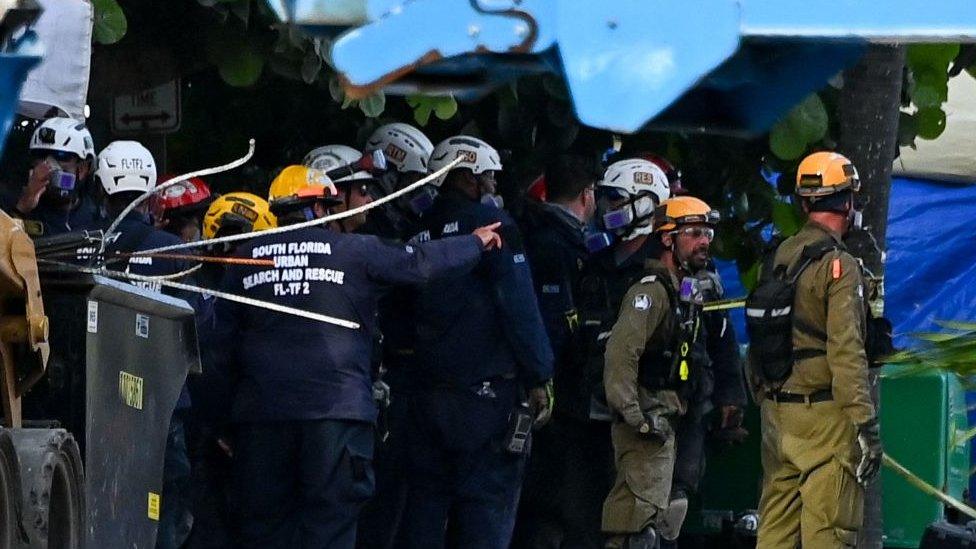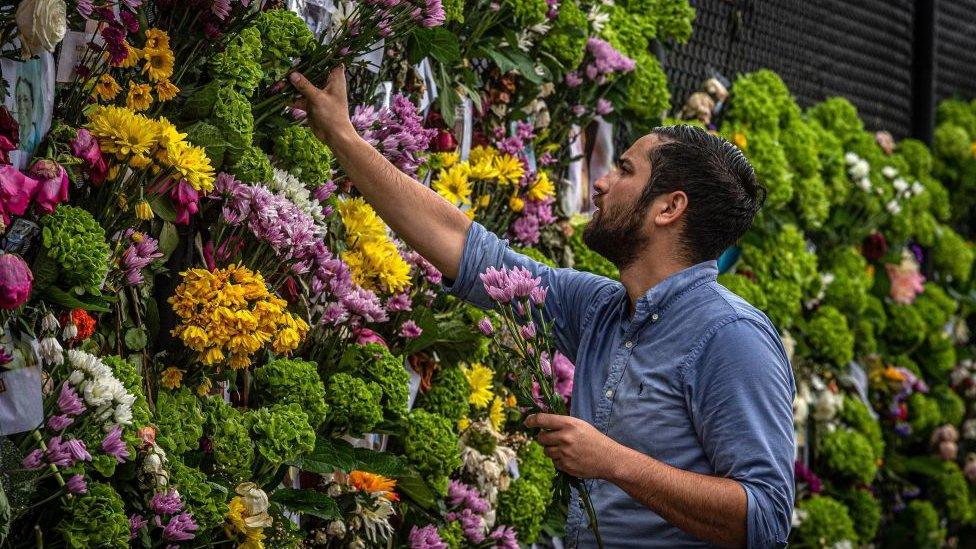Miami building collapse: Why is the rescue effort taking so long?
- Published

Heavy-lifting equipment at the scene of the collapsed Miami apartment block
Six days after the collapse of a 12-storey apartment block in the Surfside suburb of Miami, a painstaking rescue operation continues.
Some have questioned why it is taking so long. We take a look at some of the obstacles.
Risk of further collapse
Fifty-five apartments were destroyed when the block collapsed on Thursday, leaving piles of rubble intertwined with concrete slabs and twisted steel.
Surfside Mayor Charles Burkett described the building as having been "pancaked".
Twelve people have been confirmed to have died; 149 others are still missing as the search for survivors and the recovery of human remains continues. Many relatives are still waiting for news. As of Tuesday there were no new fatalities confirmed.
"We have people waiting and waiting and waiting. That is excruciating," Miami-Dade County Mayor Daniella Levine Cava said on Monday.

Rescue workers have been at the scene day and night
Some 300 rescuers, including Miami firefighters, the Army Corps of Engineers, and teams from Israel's defence forces and Mexico, are involved in the 24-hour operation.
It is a delicate situation, officials say. Go in too fast and there is the risk of further collapse, endangering any survivors who might be under the rubble.
There is dwindling hope that survivors can be located in any gaps left in the debris. Sniffer dogs, sonar devices and cameras are among the tools at the searchers' disposal. Heavy machinery has been used but carries additional risks of triggering collapse.
Commander of the Israel Defense Forces team helping the US rescue effort, Golan Vach, told relatives on Monday that the pile of debris was "in a very bad situation" with very few voids.
But he vowed his team, expected to grow to 30, would "search every narrow place we can find".
Erika Benitez, the spokeswoman for Miami-Dade Fire Rescue, was quoted in the New York Times as saying the search operation was moving as fast as it could.
"Moving something that could cause an additional collapse would be negligent," she said.
Risk to rescue teams
Rescue personnel are working in difficult conditions, hot, humid and cramped, and in 12-hour shifts.
Miami-Dade Assistant Fire Chief Raide Jadallah was quoted by AP as telling reporters: "It's not an issue of we could just attach a couple of cords to a concrete boulder and lift it and call it a day."
"Every time there's an action, there's a reaction," he said.
He cited the case of a rescue worker seen by victims' relatives falling down the pile of debris. The rescue operation would not "happen overnight" he said.

Fire and rain
The rescue effort was hampered on Friday by fire beneath the rubble, which posed further danger as well as smoke obscuring the scene.
Though it was put out over the weekend, the Miami-Dade mayor described it on Saturday as "a very deep fire" and "extremely difficult to locate".
Rain and storms have further complicated the search operation. Lightning led rescuers to pause search efforts twice.
Senator Marco Rubio of Florida told CBS's Face the Nation on Saturday: "Inside of there, there is everything from toxic chemicals to fire, smoke, all kinds of other hazards."
Trench
As part of firefighting efforts, a 125ft-long (38m), 20ft-wide trench was dug under the debris using heavy machinery.
The aim was to extend the area where rescuers could search for possible air pockets and survivors.
Rescue to recovery
With time ebbing away, the chance of finding survivors diminishes and the operation turns more to the recovery of remains.

The UN usually decides to call off similar search and rescue attempts between five and seven days after a disaster, once no survivors have been found for a day or two.
However, people have been known to survive for much longer.
In 1995, Park Seung Hyun was pulled from the wreckage of a collapsed supermarket in South Korea 16 days after it collapsed.
Experts say there comes a point where rescue workers will weigh up the risk of removing larger amounts of rubble more quickly because time is running out for any survivors.